Allowing everything to be. All that we experience is an invitation to to expand our awareness. Once we let go of resistance, the need to control or the desire to be something other than who we are at this moment, we tune in to that divine frequency which is always buzzing under the array of labels.
Category Archives: Blog
When the Lover and Love Become One
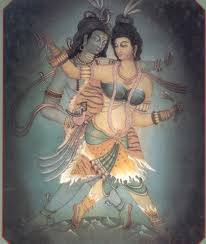 When the lover and love become one like the confluence of rivers.The resonating sound of mantra is heard in the beloveds breath, I then know I must surrender to this joyous love dance, you and me united where my body becomes the sacred mandala!
When the lover and love become one like the confluence of rivers.The resonating sound of mantra is heard in the beloveds breath, I then know I must surrender to this joyous love dance, you and me united where my body becomes the sacred mandala!
Wanderlust Festival: July 3 – 6
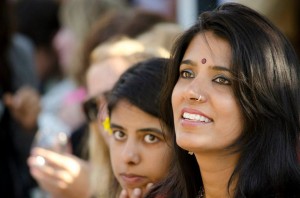
Photo by Brendan Jaffer-Thom
New this year, Wanderlust moves to the famous slopes of Aspen-Snow mass. JULY 3-6
Honored and humbled to be teaching there this year.
Join me on top of the Mountains!
Sat Chitt Ananda
We seek the quintessential bliss in objects. Coveting another dress, another pair of shoes, another car and if all else fails there is always another relationship that is sure to keep us in rapture. The truth is that trying to find the eternal in the external is like a mirage in the desert, and the moment you reach out to quench your thirst, you discover that it is Maya.
It is not lofty to assume that all of us have encountered many AHA moments in life. Those fleeting insights into samadhi, seeing the sun spread vermilion across the expanse of the blue skies, looking into the angelic face of your sleeping baby, finding the beloved in the eyes of your lover, or melting into a posture in yoga practice.
To be able reach inwards towards the fountain of ambrosia when the outside is chaotic and tequila seems to be the best answer, to touch the fullness of each breath when there is so much emptiness that filling the closet with the latest designer seems to fill the void, to embrace the divine union of Shiva and Shakti within when being alone tempts you into seeking yet another lover are a daily Sadhna.
Life will constantly present beautifully packaged temptations and nightmarish challenges. In those moments to remember the poetic words of Shankara in Nirvana shatakam — I am beyond my five senses, my thoughts, my desires, I am the eternal knowing and bliss — chiddanand roopah shivoham shivoham will avert the trail of unnecessary karma for our actions will be guided with equanimity.
The Holidays and Wellness
Gift Certificates available to purchase for yourself or a loved one!
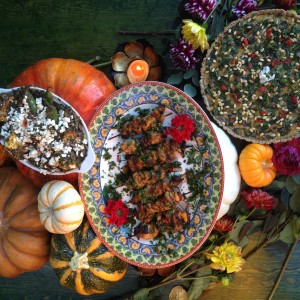 Home-Made Paneer
Home-Made Paneer
Paneer is a fresh cheese common in Indian cuisine. It is an un-aged, acid-set, non-melting cheese. Unlike most cheeses in the world, the making of paneer does not involve rennet as the coagulation agent. It is generally unsalted but it can be made with different spices like ginger, carom, jalapeno peppers, black pepper or a mixture and used by itself as a snack either served warmed on a griddle or raw. The plain paneer can be made into many varieties of dishes or served dry with a blend of special spices called Tandoori masaala and then broiled in an oven with green bell peppers and onions.
Biryanis
Biryani is a special blend of basmati rice, chicken, lamb, fish, vegetables or lentils. The rice and the other items are cooked separately with exotic spices like saffron, cardamom, mace, cloves, etc. and then put in layers. The mixture is then simmered over low heat allowing for the perfect marriage of flavors, creating a fragrant dish which is sure to awaken the taste buds. It is served with a side of Raita (savory yogurt made with different vegetables and mint).
Persian Stuffed Cornish Hens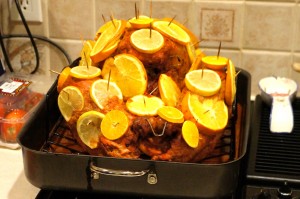
and many more varieties of meat dishes
Cornish hens that gave been stuffed with rice, nuts, dates, vegetables, spices, and cheese and then cooked with well-flavored broth. A meal by itself.
Cranberry Chutney
A special twist to your usual cranberry sauce which will leave your taste buds tingling with satisfaction. All kinds of other chutneys also available.
Ghee
Special clarified butter which can be used for cooking or given away as gifts. Plain ghee, spiced ghee, and medicated ghee available.
Ayurveda Face Treatments, Shirodharas, Back Marma and Cleanses
All treatments offered in the comfort of your home.
A Matter of Perspective
I was walking down the aisle of Trader Joe’s in Santa Fe in a salwar kameez, bindi, jutis… my regular attire when I am not working out or torturing my beloved clients. I am lost in thoughts of spicy fish vindaloo and steamed rice for dinner, salivating at the aroma of crispy cinnamon toast with creamy brie sprinkled with rosemary and honey for breakfast, when I am startled from my deep food samadhi by an accented “Namaste.” A white man in a saffron kurta and white pajamas, with disheveled hair and a rudraksha mala around his neck has obviously figured out I am Indian. I fold my hands in Namaste and smile. This leads to a conversation, with him trying to speak all the Hindi words in his vocabulary. He tells me that he lives in India the majority of his year, spends his time in prayer and meditation, and works for the betterment of poor, downtrodden Indian women.
I tell him that I am grateful for the work he is doing in the land of my birth, fold my hands again, saying Namaste, while the gorgeous, peachy butternut squashes are calling to me so I can morph them into a soup. Ass I begin to walk away, saying, “It was nice to meet you…” Anandaji (the spiritual name he has taken) tells me how lucky I am to be living here in the states, which is so much safer for me.
I stop, there are a hundred answers, a million defenses going through my head, the nationalist Shibana saying silently, “What are you doing living in my country…taking an Indian name and Indian garb if its so unsafe?” This is where the teaching of patanjali comes in: I tell myself, vrittayah pancatayah klishta aklishta, (the afflictions of the mind, the coloring of thoughts cause a fluctuation which become the breeding ground of samskaras). I say a silent Om and turn to him with a smile, saying that he, trying to live the life of sadhu, should know that safety is just a construct of the mind. I felt and feel safe in India as much as I do here as I walk towards the pungent, warm ginger which will balance the sweetness of the squash in the soup.
I am driving to my client’s home today afternoon on Old Santa Fe Trail. The golden autumn sun is shining through my windows, the breeze caressing my skin has the crispiness of fall, the yellow leaves on the trees are offering themselves to the earth, and autumn is the season that teaches about the impermanence of everything. My head and face are covered in a pink scarf, protecting my skin from the sun, a habit from years so long back that it seems as natural as putting on my sunglasses when to protect from the glare of the brilliant sun. The melody of a Bollywood song sings “subhan Allah”(glory to Allah) loudly. I slow down as I come to a turn, and a group of middle aged white tourists look at me oddly, perhaps because my scarf could be mistaken for a hijab, perhaps it is the continuous rendition of subhan allah from the car, perhaps it is the small Indian flag sticker I put on my car in a moment of nostalgia towards my homeland… perhaps it is my imagination, but my heart begins to thump loudly, I remember the incident of a Sikh professor being assaulted just the day before because he was mistaken for a Muslim. I could easily be shot or assaulted in a hate crime, I think, lowering the volume of the song, and gratefully parking in my client’s driveway. I take a look in the mirror with my scarf still on, see the fear that had momentarily made home in my eyes and say softly that safety is indeed a construct of the mind, not forgetting that this how my many dear Muslim brothers and sisters feel everyday in this safe land, as the whiff of the sweet, comforting ginger date pie I made that morning wraps itself around me!
Svadhyaya
There is something about running a fever, as the body writhes and groans in physical pain, that makes the mind become still and quiet. It is possible that as one lies alone agonizing over the physical discomfort, that the sensory stimulation we inhale every moment in our culture is greatly reduced. Tada drastuh svarupe vasthanam. (Then the seer abides in its own nature)
Having lived 13 years in this country and considering myself to be a true citizen of the world, it is shocking how a dose of physical discomfort can make me long for the familiarity of what I grew up with. It just goes to show that it is truly egotistical to call ourselves yogis just because we go through some physical postures on a regular basis, or even sit doing japa and dhayana everyday. After all, the yogis are known to go through conscious suffering to reach a state of awakening where there is no difference between pain and comfort, and there is continuous sense of upeksha (equanimity). They do not long for their mothers loving touch or a friend’s hearty soup the moment the temperature of this physical body rises above a 101.
It amazes me that how things that seem culturally normal on a regular day become a cultural shock on days when the body is not at its optimum, reinforcing the teaching of the yoga sutras that the physical practice of yoga is important because a healthy body harbors a healthy mind. If the body is restless and inflexible the mind is bound to become agitated and rigid. On most days, a text message from a friend saying hope all is well is the norm and a lovely way to be in touch in the busy lives we lead in the west. It seems to become a detached formality when you have told your friends you are sick, even if that means your mind has succumbed to the sensations of the body and perhaps exaggerated the heat of the skin and the fog in the head to “really sick”.
I crave for the intrusion of my friends and family, coming to visit and bringing with them bowls of hot khicari, soothing stews, homemade remedies and comforting tales. I want the laughter of friends who are not afraid of being infected by my terrible disease, the stories of the flu running in their households and the constant irritant of my father’s voice telling me to eat.
Once I am over missing mommy and feeling sorry for myself, I try to witness these thoughts, I try not to make them more than they are, I try to enjoy the home delivery of Chinese food. I express gratitude for all the loving thoughts being sent my way and at the risk of sounding like a broken record, take this as moment of expansion, knowing that everything is teaching us and this time has been gifted to me for svadhyaya (self inquiry).
Finding the Lusciousness in Life
The Guest House
This being human is a guest house.
Every morning a new arrival.
A joy, a depression, a meanness,
some momentary awareness comes
As an unexpected visitor.
Welcome and entertain them all!
Even if they’re a crowd of sorrows,
who violently sweep your house
empty of its furniture,
still treat each guest honorably.
He may be clearing you out
for some new delight.
The dark thought, the shame, the malice,
meet them at the door laughing,
and invite them in.
Be grateful for whoever comes,
because each has been sent
as a guide from beyond.
–Rumi
In the yogic practice we often talk about detachment from our emotions, but since few of us know what this really means, we go about the lila (play) of life expressing “detachment” as buttoned up and unfeeling. This often gives the impression that life on the spiritual path is dry and lusterless.
The true expression of vairagyam (loosely translated as detachment) is not freedom of emotions but rather a freedom in emotion.
Vairagyam is the ability and clarity to move through the rise and fall of different emotions, even play with emotion as the situation demands.
The word Rasa comes from Ayurveda and is translated as the juice, the flavor of food.
In Ayurveda we believe that there are six tastes and every meal should be created in a way that satisfies the six tastes. Just like an experienced chef will use different spices, flavors, and ingredients to satisfy the palate, an artist will use many colors, ideas, and textures to create a piece that feels balanced, We as human beings crave different rasas in our life, which in its deeper meaning, means the lusciousness in life.
Abhinavgupta, the greatest teacher of tantra, has identified 9 rasas or emotions:
- erotic
- comic
- pathetic
- furious
- heroic
- terrible
- odious
- marvelous
Obviously not everyone will be attracted to every rasa, the key is not to get stuck in one rasa and be judgmental about the others with the knowledge that even the most juicy and delicious of foods can get dull if it is the only flavor on the plate. Vairagyam is learning that there is a pathos in every comedy and it does not take long for a poignant, romantic moment to morph into a full-blown argument.
The key to letting your consciousness experience and move through a buffet of emotions is to truly drink in the experience, tasting and swirling each sip like a glass of aged wine.
Do not mix this with letting your emotions take over. This kind of separation arises only when you have realized that you are not your emotions, when you have recognized that all rasas have a purpose and can be transformed to serve and you learn to become a witness to your emotions. This recognition of the rasas and learning to transform them is the basis of all tantrik rituals.
As you become intimately connected with your emotions, you will be guided on how to transform or express them while they are still budding leading you to deeper understanding that all rasas are necessary to weave the beautiful, colorful, and magical tapestry of life.
I THANK YOU ALL WITH FOLDED HANDS FOR TEACHING ME THE TRUE MEANING OF VASUDEVA KUTUMBAKAM (THE WORLD AS ONE FAMILY) FOR CONSTANTLY BEING MY TEACHERS AND HELPING ME EXPERIENCE THIS JUICY RASA OF LIFE, FOR THE SPARK THAT LIGHTS YOUR BEINGS.
I AM BECAUSE YOU ARE!!!
Namaste, in gratitude
The Lila in this Cosmic Playground
The lila in this cosmic playground, the constant discovery of the new day, the new role. The dance to the tune of the inner song… to radiate, to play, to be joyful, to divert and to delight… that is the YOGA.
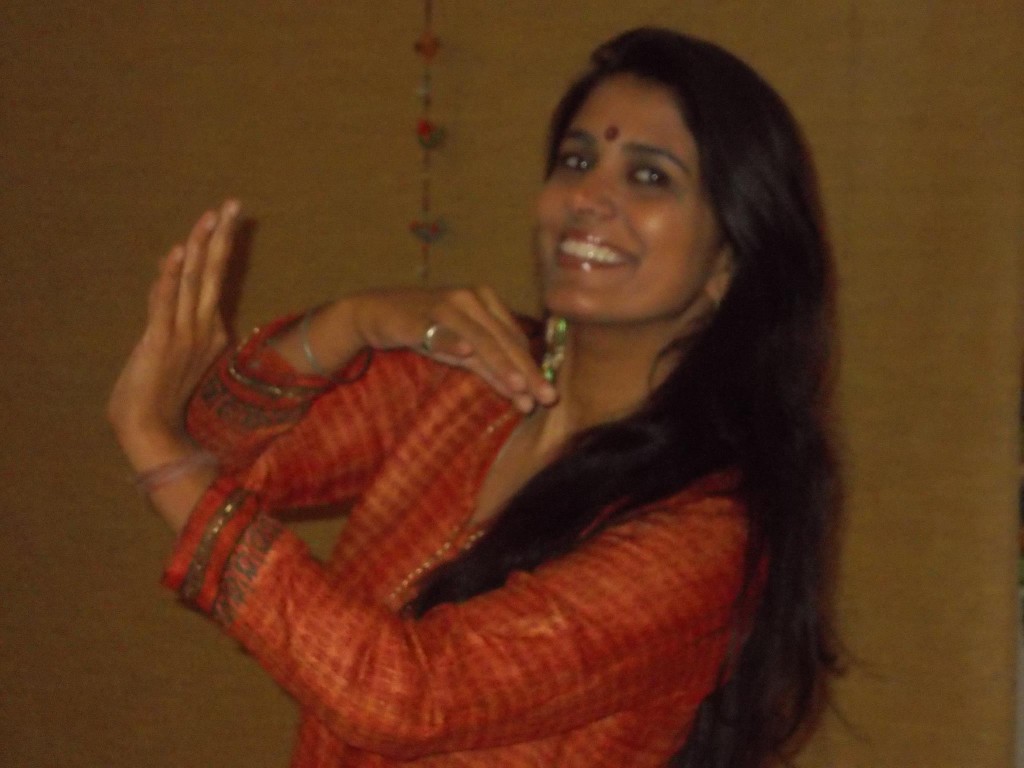
I Am Because You Are
ALL OF LIFE IS A MEDITATION,EVERY SITUATION AN OPPORTUNITY FOR EXPANSION… the awareness and awakening I experience every day in my work… sometimes in the serenity of teaching yoga, sometimes in the clanging of weights,sometimes in the endorphin release of endurance, sometimes in the santosha (contentment) of cooking meals, sometimes in the stillness of meditation, give my mind, body and spirit the same release and respite as spending a few days in a retreat or ashram and for this I fold my hands in gratitude to the enriching interaction with each one of my clients… “I am because you are.”



